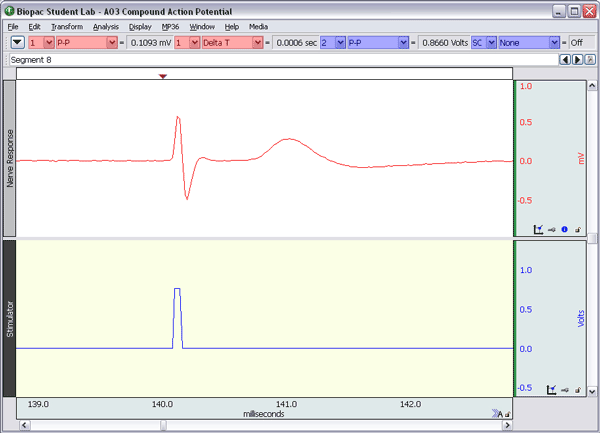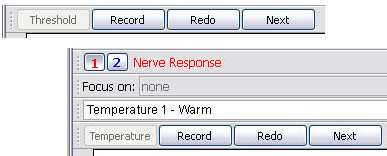A03 Frog Sciatic Nerve

Experimental Objectives
- To record the CAP of the frog sciatic nerve and measure the latent period.
- To record the effect, on the amplitude of the CAP, of subthreshold, threshold, submaximal, maximal, and supramaximal stimulation of the sciatic nerve.
- To record the effects of temperature on the velocity of nerve impulse conduction.
- To record the effect on the ability of the nerve to conduct impulses before and after the application of a local anaesthetic.
- * To estimate the refractory period of the nerve.
- * To explore the relationship between stimulus strength and duration.
- * To determine average conduction velocity.
* These objectives are covered in the introductory text and recording template for BSL 4.0.1 or above only.
Tasks Performed by the Student
- Optional: Use string as an experimental control to record and examine Stimulus Artifact.
- Stimulate the nerve at subthreshold, threshold, submaximal, maximal, and supramaximal levels.
- Irrigate the nerve with warmed Ringer’s and then stimulate until Threshold is observed.
- Irrigate the nerve with cold Ringer’s and then stimulate until Threshold is observed.
- Saturate the nerve with a nerve blocker and then stimulate until Threshold is observed.
Videos
Biopac Student Lab Student Download
Student Prep & Distance Learning
Click the link(s) below for sample data and/or lesson procedure video(s), BSL PRO Lesson procedures (PDF) for human lessons*, and graph template files (*.gtl) for BSL PRO Lessons. If more than one .gtl is available, download the .gtl with the _suffix to match BSL version and hardware.
Lesson Hardware
This lesson requires a Biopac Student Lab (BSL) System and the following hardware. If your BSL System does not include all hardware items, expand your system by selecting required items below. For more details, review the Lesson: L# BSL Lessons - see the Lab Manual or launch BSL; A# and H# BSL PRO Lessons, click the PDF link above to review full setup, recording, and analysis procedures.

Stay Connected